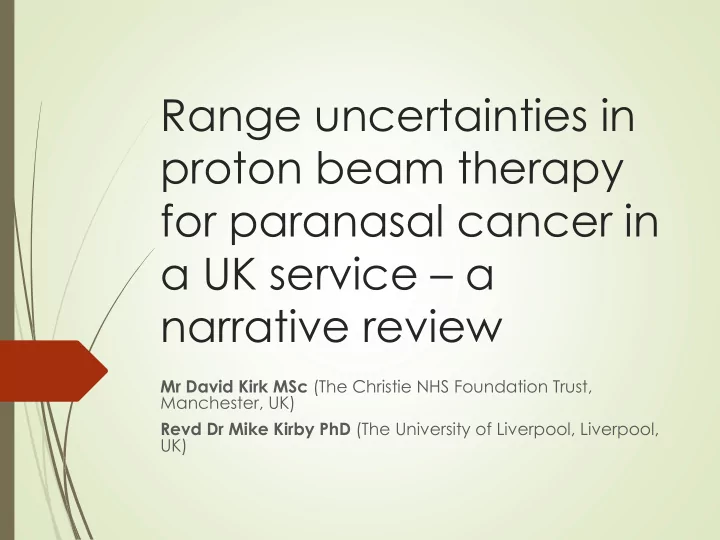

Range uncertainties in proton beam therapy for paranasal cancer in a UK service – a narrative review Mr David Kirk MSc (The Christie NHS Foundation Trust, Manchester, UK) Revd Dr Mike Kirby PhD (The University of Liverpool, Liverpool, UK)
Rationale for this work 2 New NHS High Energy Proton Beam Therapy (PBT) facility opening in Manchester autumn 2018 Within the outline business case, identified that patients with paranasal cancer would be one of a number of cancers which would benefit from PBT Anticipate potential improvement in local control and reduction in complications Although advantageous with respect to normal tissue toxicity, the Increased conformity from PBT is vulnerable to considerable error as a result of uncertainties in beam range PBT more sensitive to anatomical changes than with photon therapy MSc Dissertation of David Kirk (A Superintendent Radiographer (RTT) for the Christie PBT facility)
3
Aims and Objectives 4 Examine in a systematic way the evidence base for the various known range uncertainties which might affect paranasal cancer treatments for the new UK PBT service Explore the extent of the uncertainty Extract the effectiveness of proposed corrective actions
Methods used 5 PubMed database used for key searches related to range uncertainty in PBT in general and for PBT for paranasal sinus treatments in particular Initial search in April/May 2015 and monthly thereafter; using appropriate keywords, inclusion and exclusion criteria Follow-up search in Feb 2018 Papers were filtered and appraised critically for relevance and robustness From an initial search result of over 220 papers… 97 papers were reviewed for range uncertainty (16 in Feb 2018) 7 papers specific to paranasal cancer (8 in Feb 2018)
Main Results Found 6 Patients should ideally undergo prep/planning without a fluid filled sinus Adequate drainage, if possible, provided surgically beforehand Status monitored throughout treatment – volumetric imaging (CBCT) or verification CT Impact of weight change can be less problematic for well- optimised plans Distal end of SOBP never against an OAR if significant weight change anticipated Variations in RBE across peak are of concern; of current debate – tomorrow’s teaching lecture! Std value of 1.1; literature 1.07 – 1.18 for mid-SOBP Margin of uncertainty should be examined for each site/individual cases
Clinical Impact 7 Establish clinical protocols which are informed by.. Experience from current, global PBT centres and their treatment for these cancers Evidence base and review for Paranasal cancer patients treated with PBT Potentially provide a platform for more effective treatment with this cohort of patients and….. Establish foundation for further development of the clinical techniques – e.g. for Intensity Modulated Proton Therapy
Future directions 8 The NHS UK PBT Service has opted for the Varian ProBeam system and Eclipse TPS; due for clinical implementation in 2018 (Manchester) and 2020 (London) This work is helping to inform the set-up and establishment of clinical protocols for the new service Part of the training and education for all staff involved with PBT, especially Radiographers (Radiation Therapists) Especially of note is the development of an understanding and knowledge base for the critical differences between photon and proton therapy
Any questions? 9 Thanks for your attention!
Recommend
More recommend